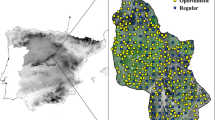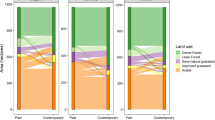Abstract
Agricultural modification commonly leads to reductions in vegetation matrix quality and a resultant decrease in functional connectivity. In this study, a network analysis approach was used to assess the impact of agriculturally-induced reductions in vegetation matrix quality on the metapopulation dynamics of the critically endangered New Zealand grand skink (Oligosoma grande). Vegetation matrix quality was quantified in four sites exhibiting differing levels of modification within indigenous tussock grasslands in eastern Central Otago, New Zealand. Grand skink occupancy probability exhibited a positive correlation with the structural connectivity of primary habitat within the more modified study sites, whereas in the least modified site a complex matrix appeared to compensate for low structural connectivity. Results from this research indicate that the matrix is an important determinant of grand skink metapopulation dynamics and that an intricate balance exists between structural connectivity and the quality of the vegetation matrix. This research highlights the importance of assessing the impact of the matrix for individual species, particularly for conservation management.






Similar content being viewed by others
References
Baddeley A, Turner R (2005) Spatstat: an R package for analyzing spatial point patterns. J Stat Softw 12:1–42
Baguette M, Van Dyck H (2007) Landscape connectivity and animal behaviour: functional grain as a key determinant for dispersal. Landscape Ecol 22(8):1117–1129
Bender DJ, Fahrig L (2005) Matrix structure obscures the relationship between interpatch movement and patch size and isolation. Ecology 86(4):1023–1033
Berry O, Gleeson DM (2005) Distinguishing historical fragmentation from a recent population decline—shrinking or pre-shrunk skink from New Zealand? Biol Conserv 123(2):197–210
Berry O, Tocher MD, Sarre SD (2004) Can assignment tests measure dispersal? Mol Ecol 13(3):551–561
Berry O, Tocher MD, Gleeson DM, Sarre SD (2005) Effect of vegetation matrix on animal dispersal: genetic evidence from a study of endangered skinks. Conserv Biol 19(3):855–864
Bibby CJ (1997) Macraes ecological district; Survey Report for the Protected Natural Areas Programme. Department of Conservation, Wellington
Bunn AG, Urban DL, Keitt TH (2000) Landscape connectivity: a conservation application of graph theory. J Environ Manage 59(4):265–278
Burnham KP, Anderson DR (2002) Model selection and multimodal inference: A practical information-theoretic approach, 2nd edn. Springer, New York
Cantwell MD, Forman RTT (1993) Landscape graphs—ecological modelling with graph-theory to detect configurations common to diverse landscapes. Landscape Ecol 8(4):239–255
Cree A (1994) Low annual reproductive output in female reptiles from New Zealand. N Z J Zool 21(4):351–372
Csardi G, Nepusz T (2006) The igraph software package for complex network research. InterJournal Complex Syst 1695
Debinski DM, Holt RD (2000) A survey and overview of habitat fragmentation experiments. Conserv Biol 14(2):342–355
Dickinson KJM, Mark AF, Lee WG (1992) Long-term monitoring of nonforest communities for biological conservation. N Z J Bot 30(2):163–179
Eifler DA, Eifler MA (1999) Foraging behaviour and spacing patterns of the lizard Oligosoma grande. J Herpetol 33(4):632–639
Fahrig L (2003) Effects of habitat fragmentation on biodiversity. Annu Rev Ecol Evol Syst 34:487–515
Fischer J, Lindenmayer DB (2007) Landscape modification and habitat fragmentation: a synthesis. Glob Ecol Biogeogr 16(3):265–280
Gebauer K (2012) Dynamics of grand skink (Oligosoma grande, Gray 1945) metapopulations in indigenous tussock grasslands and exotic pasture grasslands in southern New Zealand. Doctoral thesis, University of Otago
Gustafson EJ, Gardner RH (1996) The effect of landscape heterogeneity on the probability of patch colonization. Ecology 77(1):94–107
Hitchmough RA, Hoare JM, Jamieson H, Newman D, Tocher MD, Anderson PJ, Lettink M, Whitaker AH (2010) Conservation status of New Zealand reptiles. N Z J Zool 37(3):203–224
Houghton C (2000) The dispersal and metapopulation dynamics of two skink species, Oligosoma grande and O. otagense at Macraes Flat, Otago. Masters thesis, University of Otago
Kool JT, Moilanen A, Treml EA (2013) Population connectivity: recent advances and new perspectives. Landscape Ecol 28(2):165–185
MacKenzie DI, Nichols JD, Royle AJ, Pollock KH, Bailey LL, Hines JE (2006) Occupancy estimation and modelling: Inferring patterns and dynamics of species occurence. Elsevier, San Diego
Norbury G (2001) Conserving dryland lizards by reducing predator-mediated apparent competition and direct competition with introduced rabbits. J Appl Ecol 38(6):1350–1361
Norbury G, Tocher M (2007) Simulation modelling of extinction proneness and recovery in the critically endangered grand and Otago skinks. N Z J Zool 34(3):269
Pascual-Hortal L, Saura S (2006) Comparison and development of new graph-based landscape connectivity indices: towards the prioritization of habitat patches and corridors for conservation. Landscape Ecol 21(7):959–967
Patterson GB (1992) Development of Otago and grand skink monitoring techniques (Science and Research internal report). Department of Conservation, Wellington
Prevedello JA, Vieira MV (2010) Does the type of matrix matter? A quantitative review of the evidence. Biodivers Conserv 19(5):1205–1223
R Core Team (2012) R: a language and environment for statistical computing. Version 2.15.2. R Foundation for Statistical Computing, Vienna
Reardon JT, Whitmore N, Holmes KM, Judd LM, Hutcheon AD, Norbury G, Mackenzie DI (2012) Predator control allows critically endangered lizards to recover on mainland New Zealand. N Z J Ecol 36(2):141–150
Ricketts TH (2001) The matrix matters: effective isolation in fragmented landscapes. Am Nat 158(1):87–99
Saura S, Pascual-Hortal L (2007) A new habitat availability index to integrate connectivity in landscape conservation planning: comparison with existing indices and application to a case study. Landsc Urban Plann 83(2–3):91–103
Scott D (1965) A height frequency method for sampling tussock and shrub vegetation. N Z J Bot 3:253–260
Seddon PJ, Roughton CM, Reardon J, MacKenzie DI (2011) Dynamics of an endangered New Zealand skink: accounting for incomplete detectability in estimating patch occupancy. N Z J Ecol 35(3):247–253
Severns PM, McIntire EJB, Schultz CB (2013) Evaluating functional connectivity with matrix behaviour uncertainty for an endangered butterfly. Landscape Ecol 28(3):559–569
Tilman D, Fargione J, Wolff B, D'Antonio C, Dobson A, Howarth R, Schindler D, Schlesinger WH, Simberloff D, Swackhamer D (2001) Forecasting agriculturally driven global environmental change. Science 292(5515):281–284
Tischendorf L, Fahrig L (2000) On the usage and measurement of landscape connectivity. Oikos 90(1):7–19
Tocher MD (2009) Life history traits contribute to decline of critically endangered lizards at Macraes Flat. Otago N Z J Ecol 33(2):125–137
Turner MG (1989) Landscape ecology—the effect of pattern on process. Annu Rev Ecol Syst 20:171–197
Uezu A, Metzger JP, Vielliard JME (2005) Effects of structural and functional connectivity and patch size on the abundance of seven Atlantic Forest bird species. Biol Conserv 123(4):507–519
Urban D, Keitt T (2001) Landscape connectivity: a graph-theoretic perspective. Ecology 82(5):1205–1218
Urban DL, Minor ES, Treml EA, Schick RS (2009) Graph models of habitat mosaics. Ecol Lett 12(3):260–273
Vandermeer J, Carvajal R (2001) Metapopulation dynamics and the quality of the matrix. Am Nat 158(3):211–220
Vandermeer J, Perfecto I (2007) The agricultural matrix and a future paradigm for conservation. Conserv Biol 21(1):274–277
Whitaker AH (1996) Impact of agricultural development on grand skink (Oligosoma grande) (Reptilia: Scincidae) populations at Macraes Flat, Otago, New Zealand. Department of Conservation, Wellington
Whitaker AH, Loh G (1995) Otago skinks and grand skink recovery plan (Leiolopisma otagense and L. grande). Department of Conservation, Wellington
White G, Burnham K (1999) Program mark: survival estimation from populations of marked animals. Bird Study 46:S120–S138
Acknowledgments
We are grateful to Phillip J. Seddon for comments on an earlier version of the manuscript. This research was supported by A University of Otago Postgraduate Scholarship, the Federation for Graduate Woman Brenda Shore Award and an award from the Miss E.L. Hellaby Indigenous Grasslands Research Trust. This research was undertaken under a Department of Conservation low impact research permit (#OT-27842-FLO). A number of GPS positions were kindly provided by K. Gebauer and the Department of Conservation. We are grateful for the support of landowners L. Watson, M. Sutton and G. Hand for access to private land. Deahn Donner and two anonymous reviewers provided helpful comments on the manuscript.
Author information
Authors and Affiliations
Corresponding author
Electronic supplementary material
Below is the link to the electronic supplementary material.
Rights and permissions
About this article
Cite this article
Harris, K.M., Dickinson, K.J.M. & Whigham, P.A. Functional connectivity and matrix quality: network analysis for a critically endangered New Zealand lizard. Landscape Ecol 29, 41–53 (2014). https://doi.org/10.1007/s10980-013-9967-9
Received:
Accepted:
Published:
Issue Date:
DOI: https://doi.org/10.1007/s10980-013-9967-9




